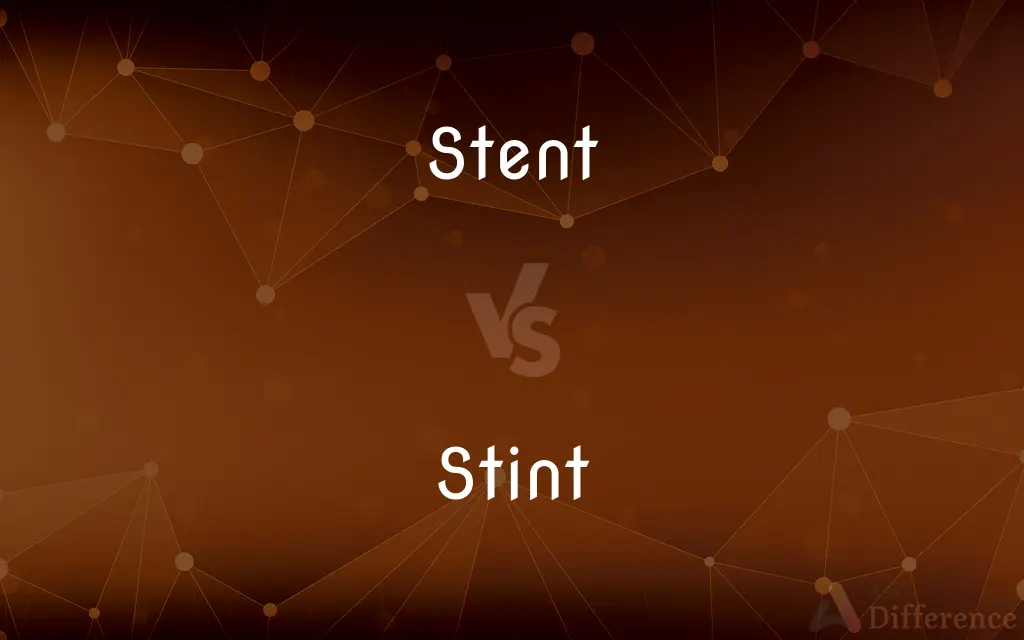Stent vs. Stint — What's the Difference?
By Urooj Arif & Maham Liaqat — Updated on March 18, 2024
A stent is a medical device for keeping vessels open; a stint refers to a limited period of work or activity.

Difference Between Stent and Stint
Table of Contents
ADVERTISEMENT
Key Differences
A stent is a tubular support placed in a blood vessel, duct, or canal to aid in healing or relieving an obstruction, commonly used in procedures like angioplasty. In contrast, a stint is defined as a specified period of time spent doing a particular job or activity or a limitation in the amount of work undertaken. This fundamental difference highlights the distinct nature of each term, one being a physical object with a medical purpose and the other a concept related to duration or limitation.
While stents are integral to medical treatments, aiming to prevent or mitigate blockages in the body's pathways and thus enhancing patient health and longevity, stints, on the other hand, deal with the allocation of time or effort to various tasks or roles. This comparison underscores the application of stents in healthcare and stints in the context of work, service, or other temporal commitments.
The use of stents has revolutionized certain medical procedures, offering solutions for conditions such as coronary artery disease by keeping arteries open and improving blood flow. Conversely, a stint often refers to brief or fixed-term engagements in professional settings, emphasizing temporary or short-duration roles rather than permanent positions. The contrast between the tangible, life-saving device and the abstract measure of time or commitment illustrates the diversity in the application and significance of each term.
In discussing practical applications, stents are specifically designed for long-term placement in the body, requiring careful consideration and often sophisticated medical intervention for insertion. Stints, however, can be voluntary or assigned, ranging from professional assignments to personal tasks, reflecting flexibility in duration and nature. This variance highlights the physical permanence of stents versus the temporal flexibility of stints.
Understanding the difference between a stent and a stint is crucial not only for medical professionals but also for individuals navigating their careers or managing their time across various commitments. Stents represent a critical component of modern medical care, particularly in cardiovascular treatment, while stints provide a framework for understanding the allocation of time and resources in both personal and professional contexts.
ADVERTISEMENT
Comparison Chart
Definition
A tube designed to be inserted into a vessel or passage to keep it open.
A period of time spent doing a specific task or a limitation in the amount of work.
Purpose
Medical intervention to prevent or treat blockages.
Allocation of time or effort to tasks or roles.
Application
Used in procedures like angioplasty or to support vessels.
Refers to temporary or fixed-term engagements and efforts.
Material/Form
Made from metal or plastic, designed for bodily insertion.
Conceptual, relating to time or duration rather than a physical object.
Impact
Aims to improve health outcomes by ensuring vessel openness.
Influences work distribution, personal development, or project completion.
Compare with Definitions
Stent
Utilized in medical procedures to treat or prevent blockages.
Stents are commonly used in the treatment of coronary artery disease.
Stint
Can involve personal commitments or professional assignments.
The volunteer stint at the shelter was a rewarding experience.
Stent
Made from materials like metal or plastic.
This stent is fabricated from a flexible metal mesh.
Stint
A specified period of time dedicated to a particular job or activity.
She did a six-month stint as a research assistant.
Stent
Can be temporary or permanent, depending on the condition.
The patient received a temporary stent during the procedure.
Stint
Often used to describe temporary positions or roles.
His stint in London expanded his expertise in the field.
Stent
In medicine, a stent is a metal or plastic tube inserted into the lumen of an anatomic vessel or duct to keep the passageway open, and stenting is the placement of a stent. There is a wide variety of stents used for different purposes, from expandable coronary, vascular and biliary stents, to simple plastic stents used to allow the flow of urine between kidney and bladder.
Stint
Reflects the allocation or limitation of time and resources.
He planned a short stint of intensive study for the exam.
Stent
A substance used in dentistry for taking impressions of the teeth.
Stint
May also refer to limiting the amount of work or effort.
Don't stint on the quality of the ingredients for this recipe.
Stent
An assessment of property made for purposes of taxation
It was recorded in the stent book
Stint
A stint is one of several very small waders in the paraphyletic "Calidris" assemblage – often separated in Erolia – which in North America are known as peeps. They are scolopacid waders much similar in ecomorphology to their distant relatives, the charadriid plovers.
Stent
Assess and charge (a person or a community) for purposes of taxation
Stent the Parish of Kildaltan in the ascertained sum
Stint
Supply a very ungenerous or inadequate amount of (something)
Stowage room hasn't been stinted
Stent
A device used to support a bodily orifice or cavity during skin grafting or to immobilize a skin graft following placement.
Stint
A person's fixed or allotted period of work
His varied career included a stint as a magician
Stent
A short tubular device made of wire mesh or fabric that is placed permanently in an anatomical passage, usually an artery during angioplasty, to keep it open after occlusion.
Stint
Limitation of supply or effort
A collector with an eye for quality and the means to indulge it without stint
Stent
(archaic) An allotted portion; a stint.
Stint
A small short-legged sandpiper of northern Eurasia and Alaska, with a brownish back and white underparts.
Stent
(archaic) To keep within limits; to restrain; to cause to stop, or cease; to stint.
Stint
To be frugal or economical in providing something; hold back
The host did not stint on the wine. He does not stint when providing advice.
Stent
(archaic) To stint; to stop; to cease.
Stint
(Archaic) To stop or desist.
Stent
To keep within limits; to restrain; to cause to stop, or cease; to stint.
Then would he weep, he might not be stent.
Yet n'ould she stentHer bitter railing and foul revilement.
Stint
To restrict (someone) in what is provided or allowed
"found his living so expensive that he had to stint his family" (William Marvel).
Stent
To stint; to stop; to cease.
And of this cry they would never stenten.
Stint
To restrict (something supplied); be sparing with.
Stent
An allotted portion; a stint.
Stint
(Archaic) To cause to stop.
Stint
A length of time spent in a particular way, especially doing a job or fulfilling a duty
A two-year stint in the military.
Stint
A limitation or restriction
Working without stint.
Stint
Any of several small sandpipers of the genus Calidris, primarily of the Eastern Hemisphere.
Stint
To stop (an action); cease, desist.
Stint
To stop speaking or talking (of a subject).
Stint
(intransitive) To be sparing or mean.
The next party you throw, don't stint on the beer.
Stint
(transitive) To restrain within certain limits; to bound; to restrict to a scant allowance.
Stint
To assign a certain task to (a person), upon the performance of which he/she is excused from further labour for that day or period; to stent.
Stint
(of mares) To impregnate successfully; to get with foal.
Stint
A period of time spent doing or being something; a spell.
He had a stint in jail.
Stint
Limit; bound; restraint; extent.
Stint
Quantity or task assigned; proportion allotted.
Stint
Any of several very small wading birds in the genus Calidris. Types of sandpiper, such as the dunlin or the sanderling.
Stint
Any one of several species of small sandpipers, as the sanderling of Europe and America, the dunlin, the little stint of India (Tringa minuta), etc. Called also pume.
Stint
Limit; bound; restraint; extent.
God has wrote upon no created thing the utmost stint of his power.
Stint
Quantity or task assigned; proportion allotted.
His old stint - three thousand pounds a year.
Stint
To restrain within certain limits; to bound; to confine; to restrain; to restrict to a scant allowance.
I shall not go about to extenuate the latitude of the curse upon the earth, or stint it only to the production of weeds.
She stints them in their meals.
Stint
To put an end to; to stop.
Stint
To assign a certain (i. e., limited) task to (a person), upon the performance of which one is excused from further labor for the day or for a certain time; to stent.
Stint
To serve successfully; to get with foal; - said of mares.
The majority of maiden mares will become stinted while at work.
Stint
To stop; to cease.
They can not stint till no thing be left.
And stint thou too, I pray thee.
The damsel stinted in her song.
Stint
An unbroken period of time during which you do something;
There were stretches of boredom
He did a stretch in the federal penitentiary
Stint
Smallest American sandpiper
Stint
An individuals prescribed share of work;
Her stint as a lifeguard exhausted her
Stint
Subsist on a meager allowance;
Scratch and scrimp
Stint
Supply sparingly and with restricted quantities;
Sting with the allowance
Common Curiosities
Are stents visible on an X-ray?
Yes, most stents are made from materials that are visible on an X-ray.
Can stents be removed?
Some stents are designed to be temporary and can be removed; others are permanent.
What does doing a stint mean?
Doing a stint refers to spending a specific period doing a job or activity.
Is a stint always work-related?
No, a stint can refer to any dedicated period of time for various activities, not just work.
What materials are stents made from?
Stents are commonly made from metal or plastic materials.
What does it mean to not stint on something?
It means not to limit or be sparing with something, often referring to effort or resources.
Can anyone have a stent?
The need for a stent depends on medical conditions and is determined by a healthcare professional.
How long does a stint typically last?
The duration of a stint can vary widely, from days to years, depending on the context.
Why might someone do a short stint in a job?
Reasons can include gaining experience, filling temporary needs, or personal preference.
How is a stent placed in the body?
A stent is placed during a medical procedure, often involving a catheter inserted into a vessel.
How do stents and stints relate to overall well-being?
Stents directly contribute to physical health, while stints can affect professional growth and personal satisfaction.
Can a stint be extended?
Yes, the duration of a stint can often be extended based on agreement and circumstance.
Is a stint considered employment?
A stint can be considered employment if it involves performing work for compensation.
Share Your Discovery

Previous Comparison
Tardy vs. Late
Next Comparison
Waddle vs. WattleAuthor Spotlight
Written by
Urooj ArifUrooj is a skilled content writer at Ask Difference, known for her exceptional ability to simplify complex topics into engaging and informative content. With a passion for research and a flair for clear, concise writing, she consistently delivers articles that resonate with our diverse audience.
Co-written by
Maham Liaqat














































